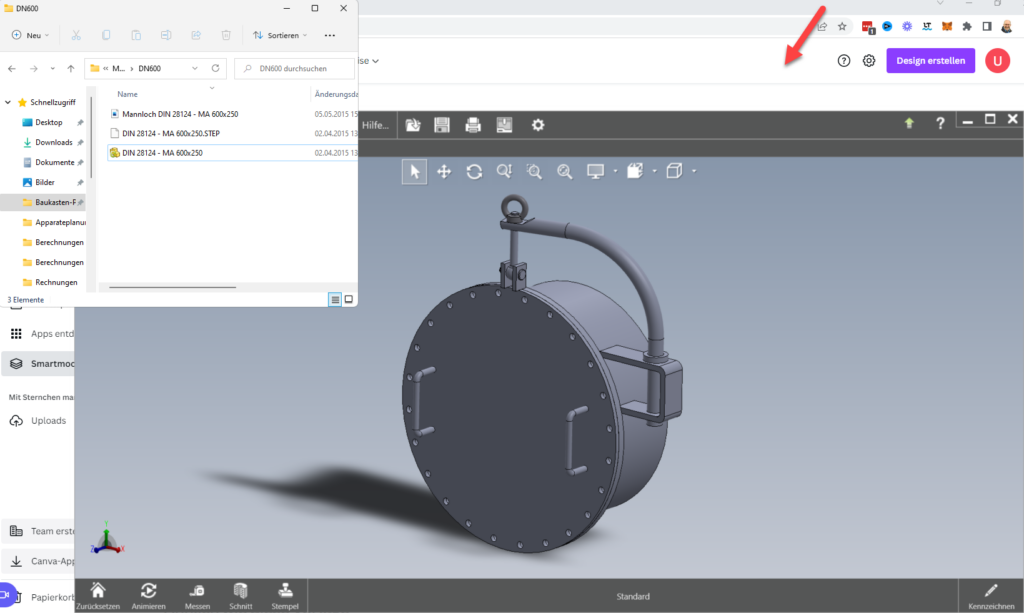Discover the secrets of CAD libraries in this detailed guide. Discover the latest trends and applications.
In the world of construction and engineering, time is money, as we all know. The ability to implement projects efficiently and precisely is therefore invaluable. This is where the 3D CAD library comes into play, a tool that not only reduces the workload but also increases the quality of the work. But what exactly is a 3D CAD library? How does it differ from conventional methods? And above all, how do you choose the right library for your needs?
This comprehensive guide is designed to give you a deep insight into the world of 3D CAD libraries. We will discuss the importance of a well-organised CAD library for engineers and designers, go through the selection criteria and take a look at future trends and developments. Whether you are an experienced engineer or a beginner in the industry, this article will provide you with valuable insights and practical tips.
The 3D CAD library is an integral part of modern design processes. It serves as a kind of "digital warehouse" in which a large number of standardised and specialised components are stored. These components can be easily integrated into new or existing projects, which speeds up the entire design process. Furthermore, the models stored in a 3D CAD library are usually of high quality and comply with current industry standards, which minimises the likelihood of errors and delays.

Why a 3D CAD library is indispensable
In today's fast-paced world of technology, efficiency is everything. For engineers and designers who are constantly under pressure to deliver high-quality work in the shortest possible time, a 3D CAD library can be a real lifesaver. But why is that?
Importance for engineers and designers
A 3D CAD library provides a one-stop shop for standardised components that can be reused in different projects. This eliminates the need to start from scratch each time and enables faster and more accurate work. The library acts as a kind of "digital archive" that not only increases efficiency but also ensures the quality of projects.

Time and cost efficiency
Using a 3D CAD library can bring significant time and cost savings. Instead of designing each component manually, engineers and designers can draw on an extensive collection of prefabricated components. This reduces the time spent on design and allows resources to be freed up for other important aspects of the project, such as quality assurance or customer communication.
Table: Comparison between manual creation and use of a library
| Criteria | Manual creation | Use of a 3D CAD library |
| Time | High | Low |
| Costs | High | Low |
| Accuracy | Variable | High |
| Flexibility | High | Medium |
Through the comparison, it becomes clear that using a 3D CAD library is the more efficient choice in most cases, especially when it comes to time and cost savings. However, it is important to choose the right library that meets the specific needs of the project and the team. A well-organised and comprehensive library can make the difference between a successful and a failed project.

Selection criteria for a 3D CAD library
Choosing the right 3D CAD library is a decisive step that needs to be carefully considered. Not every library is suitable for every project or industry. Here are some important criteria to consider when making your choice.
Quality of the models
The quality of the models included in the library is of utmost importance. Make sure that the models are detailed and to scale. A high-quality library should also be regularly updated to meet the latest standards. This is especially important in industries that are rapidly evolving and where compliance with standards and regulations is critical.
Compatibility with CAD software
The library of your choice should be compatible with the CAD software you already use. This facilitates integration and enables a smooth workflow. Another aspect is the library's ability to interact with other software tools. This can be especially useful if your team uses different software solutions for different tasks.
FAQ: Frequently asked questions about choosing a 3D CAD library
- Is the library compatible with my CAD software?**
- Check the specifications and requirements of the library.
- How extensive is the library?**
- An extensive library offers a wide range of components that can be useful for various projects.
-Are regular updates offered?**
- A good library is regularly updated to meet the latest standards and technologies.
- What is the support like?**
- Good customer service can be a great help with technical questions or problems.
Choosing the right 3D CAD library can make the difference between a successful and a less successful project. So take the time to look at different options and find the solution that suits you best. Investing in a high-quality library will pay off in the long run, both in terms of efficiency and quality of work.
Future trends and developments
Technology never stands still, and this also applies to 3D CAD libraries. It is important to keep an eye not only on current possibilities but also on future trends and developments. So what can we expect in the near future?
AI-supported libraries
Artificial intelligence is increasingly making its way into the world of CAD technology. AI-supported libraries can, among other things, automatically suggest the most suitable components for a given project, which significantly reduces the workload. Likewise, AI algorithms can also play a role in quality assurance by detecting possible errors or inconsistencies in the models at an early stage.
Cloud-based solutions
The cloud provides a flexible and scalable platform for storing and accessing CAD models. Cloud-based 3D CAD libraries enable efficient collaboration, as team members can access the resources they need from anywhere. This is particularly beneficial for companies that operate in multiple locations or even internationally.
Integration into specialised industry software
The future could see an even closer integration of 3D CAD libraries into specialised software for specific industries such as mechanical engineering, architecture or medical technology. This would enable even more efficient and targeted work. It is also conceivable that libraries will increasingly integrate functions for simulation and analysis, which would further optimise the entire development process.
The world of 3D CAD libraries is constantly changing, and it's exciting to see what innovations await us in the coming years. By keeping an eye on the trends, you can ensure that you are always up to date and making the most of the resources available.

Conclusion
In the complex and demanding world of Construction and engineering, the right 3D CAD library can make all the difference. Not only does it provide an efficient way to produce high-quality work, but it also allows for better collaboration and flexibility. From choosing the right library to considering future trends, it is important to be informed and up to date.
The 3D CAD library is more than just a collection of models; it is a tool that supports engineers and designers in their daily work. And as we have seen, technology is constantly changing. Therefore, it is crucial to continuously educate yourself and be open to new developments. The importance of the 3D CAD library will continue to grow in the coming years, especially with the advent of new technologies such as AI and cloud computing. It is therefore advisable to get to grips with these trends at an early stage and develop appropriate strategies for integrating them into one's own work processes.
If this article has provided you with valuable insights and information, please feel free to share it or contact us for more information. We are always ready to share our knowledge and experience with you. We also offer specialised services and products that can help you realise the full potential of your 3D CAD projects. Take this opportunity to take your efficiency and quality to the next level.
 CAD standard parts How to save 50% time - design quickly and easily
CAD standard parts How to save 50% time - design quickly and easily